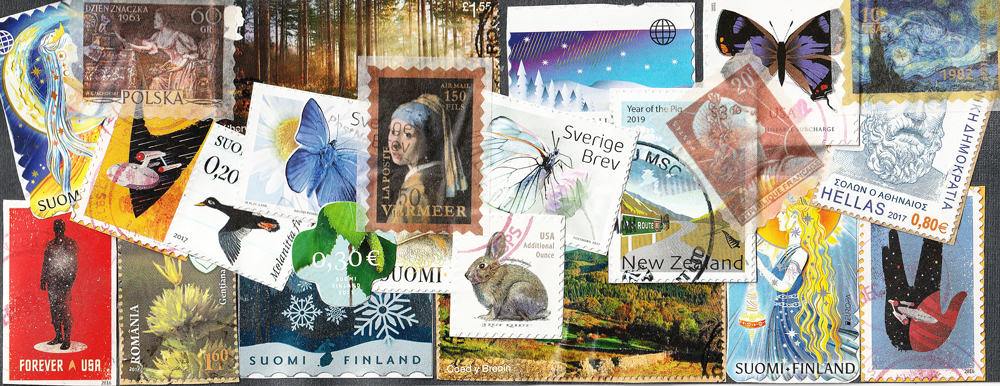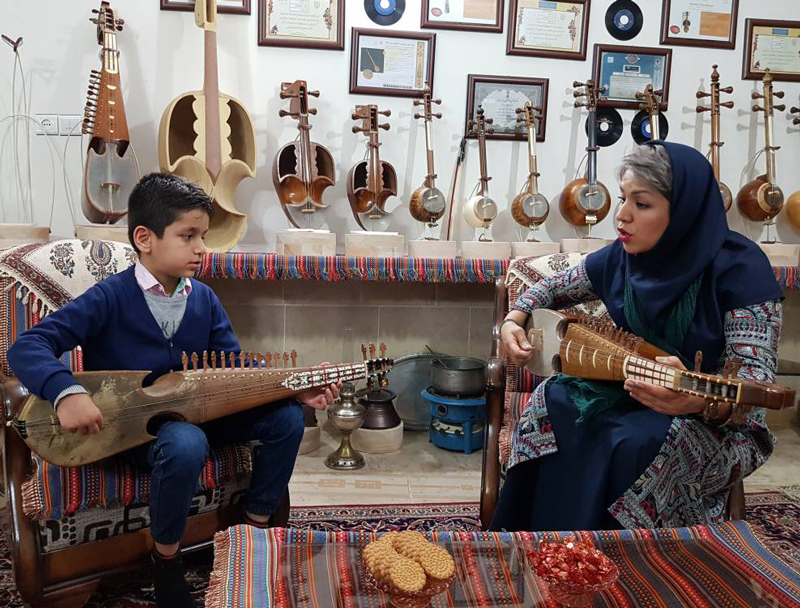(headline image: A female Rubab master is teaching a child student how to keep the fret and pluck to play the notes – Photo by Shahab Nikman, Iran, 2020)
In 2024, UNESCO recognized the art of crafting and playing the rubab (also known as rabab) as a part of humanity’s shared cultural heritage. This recognition underscores the instrument’s profound cultural, social, and historical significance in Afghanistan, where it is considered the national musical instrument, as well as in Iran, Tajikistan, and Uzbekistan.
The rubab, one of the oldest known musical instruments in Central, South, and Southwest Asia, is a short-necked, plucked string music instrument. The instruments’ body is mostly made up of dried pieces of mulberry wood. The rubab has a bird-head-shaped crown joined to a one-piece body, including a neck and two hollowed bowls that serve as sound chambers.
The neck is typically decorated with artwork from shells or camel bone. The upper triangle-shaped bowl (chest) is covered with wood, while the lower oval-shaped bowl is covered with gazelle, goat, or sheep hide, upon which the bridge rests.
The strings are made of silk, gut, metal, or nylon, fixed on tuning pegs. They pass through a bridge, and are affixed to the bottom of the lower bowl. Conventionally, there are three to six main strings and up to twenty-five tuneable sympathetic strings.
The rubab is crafted in various sizes; the large one is called shah-rubab. In some regions, the rubab is called Afghan, Badakhshani or Bukhara rubab.
Building a rubab is a traditional craftsmanship skill, including carpentry, woodcarving, marquetry, and inlay. It usually takes up to several months to make a rubab. The crafting skill is mostly transmitted practically, generation to generation, from masters to apprentices.

The rubab is used in a range of cultural activities, from celebratory events like weddings and gatherings to somber occasions such as funerals and ritual healings. Its versatility also extends to contemporary orchestras and multinational musical ensembles, bridging traditional and modern artistic expressions.
Notably, the rubab is a cultural connector across communities. Indeed, its presence is especially significant in communities such as the Baloch of Afghanistan and Iran; Uzbeks of Uzbekistan and Afghanistan; Tajiks in Tajikistan and Uzbekistan (especially in Samarkand and Bukhara); and Pashtun and Sistani groups in Iran and Afghanistan. In these regions, the rubab is often linked to spiritual and social traditions, revered by Sufi orders such as Naqshbandi, Chishti, Qaderi, Suhrawardiyya, and Zahabiya.
While deeply embedded in rural life, where it is central to community celebrations and folk traditions, the rubab also thrives in urban settings. Art schools, universities, and specialized workshops in cities across Afghanistan, Iran, Tajikistan, and Uzbekistan offer training in both crafting and playing the instrument. These institutions ensure the preservation of its traditions while adapting to contemporary musical trends.
Afghanistan
In Afghanistan, the rubab holds significant cultural value among Pashtun, Baloch, Tajik, Sistani (Zabulistan), and Hazara communities. Moreover, it is deeply intertwined with Baloch, Naqshbandi, Chishti, and Zahabiya traditions, forming a vital part of social and spiritual gatherings.
Craftsmanship is primarily concentrated in major cities like Kabul, Herat, Mazar-i Sharif, Kandahar, and Jalalabad. While some artisans craft rubabs full-time, many engage in the trade as a secondary occupation. The skill of rubab crafting has historically been passed down through family lines, predominantly among men, with the Pashtun community particularly well-represented in this art form.
Iran
The rubab serves as a vital component of folk music in Iran and is highly respected in maqam performances, traditional Iranian music, and even the national orchestra. Its traditions thrive particularly in eastern regions among Afghan, Baloch, Sistani, Khorasani, Naqshbandi, Chishti, Qaderi, and Suhrawardiyya communities.
Prominent organizations include Iran Music Association; Iran Music House; Kerman Music Association; Kermanshah Music Association; Kamkar Family Ensemble; Mana Ensemble; The ensemble of Ancient Instruments (Sazhaye Kohan); Mana Naqsh Art & Culture Institute; The Research Institute of Cultural Heritage and Tourism; Mansion of Art (Kooshk-e Honar, Atieh Iranian) Institute; Navay-e Rubab-e Sistan Art Institute; Mahoor Institute of Culture and Arts; Darvish Khan Institute; The Guilds of Handicrafts; Music Instruments Stores in Tehran and other major cities; Amir Khosraw Balkhi Foundation (Active in Afghanistan, Iran & Tajikistan); Khoshnavaz Family Ensemble (Active in Afghanistan & Iran); Master Karim Karimi Ensemble (Active in Afghanistan & Iran); Del Ahang Family Ensemble (Active in Afghanistan & Iran). All these organizations provide training and promotion for rubab musicians and craftsmen.
Master musicians include Shahram Nazeri, Mohammad Reza Darvishi, Bijan Kamkar, and Hossein Alizadeh.
Players and instructors: Abolghasem Hosseini Nejad, Bijan Kamkar, Hossein Alizadeh, Faroogh Rahmani, Rahmatollah Davoudi, Amir Khosrow Siahani, Mohammad Moheb Zehi, Adel Hosseini, Misagh Mehrpour, Mohammad Nasim Khoshnavaz, Ali Tavakkoli, Maryam Haji Malian, Shahab Movahed, and Laleh Zoheidi.

Craftsmen: Masoud Mohammadi, Jamshid Sabet Rasekh, Omar Sepahi, Abbas Ali Kool, and Adel Hosseini.
Tajikistan
In Tajikistan, the rubab is especially significant in Badakhshan and among Afghan, Ismaili, and Sufi communities, including Naqshbandi and Qaderi followers. The instrument is cherished not only as a part of folk traditions, but also for its role in fostering cultural identity.
Groups and organizations supporting the rubab: Public Association “Kuhhoi Pomir”; Ensemble of female rubab players (Rubābnavāz) at the State Philharmonic Society “Chaman” in Dushanbe city; the family ensemble “Kholovs” of Kulob, Khatlon region (Said Kholov, Nurullo Barotov, Sherafgan Kholov, Nazarali Kholov, Firuz Kholov, Isroil Kholov); “Boboyon” ensemble of Khujand, Sughd region (Ahrorov Azimjon, Qayumov Muhammadjon, Nuramtov Boltuboy, Ibrohimov Mirzotursun, Niyozov Sharif, Komilov Olimjon, Aliboev Bobojon, Yusufjonov Ergashboy, Olimov Zafar); the family ensemble “Kholovs” Dushanbe/Kulob city; The family ensemble “Murodovs” of Bokhtar, Khatlon region; Payvand folklore ensemble, Jabbor Rasuov district, Sughd region; The State Institute of Culture and Arts named after M. Tursunzoda; The National Conservatory of Tajikistan named after T. Sattorov; Amir Khosraw Balkhi Foundation (Active in Afghanistan, Iran & Tajikistan); and musical instruments stores.

Individual performers: Shodiev Sherali, Rahmonzoda Fazliddin, Sharifov Husein, Madkholov Abdurahmon, Toshev Akramjon, Homidov Behzod, Davlatzoda Bahodur, Yusufzoda Abdulmajid, Asomiddinov Rahimbek, and Davlatov Amirhamza.

Rubab craftsmen: Master Abdusamadov Abdughaffor, his children, and disciples, from Khijand; Suhayli Dilshodov, his two sons, and five disciples living in Roshtqal’a district; Dona Ziyoev with his two sons, from Dushanbe; Saidislom Ustoghulom from Kulob city; Alibekov Zokir, from Dushanbe; and Qizilov Khudobek, from Rushan district.

Uzbekistan
Uzbekistan has over 47 master craftsmen associated with the “Hunarmand” Association and more than 700 amateur groups devoted to the rubab. The instrument plays a crucial role in the music education system, with over 1,200 extracurricular courses offered in cultural centers and institutions like the Uzbek State Conservatory and the Academy of Choreography.
Communities in Samarkand and Bukhara, particularly among the Tajik population, uphold the rubab’s cultural significance.

Groups and organizations involved in rubab preservation and dissemination: Republican Scientific and Methodological Centre for Organization of Activities of Cultural Institutions; The State Institute of Art and Culture; The Department for the Training of Musical Instrument; Masters at the Specialized School of Design (Tashkent); The State Conservatory of Uzbekistan; The Members of the Republican Non-Governmental Organization “Hunarmand” (The Association of Craftsman); “Living Heritage” Center for Promotion of Uzbekistan; Culture and Art “Rubobchilar” learning group/class of the Dunkent; Cultural Center, “Voris” Folklore and ICH Development Center; “Dilor” Ensemble.
Master Musicians and Composers: Mirzayev, Bobokhonov, Kulabdullaev.
Players and instructors: Hassan Rajabi, Hikmat Razhabov, Rafiq Shomurodov, Tohir Yuldashev, Abu Bakr Umataliev, Adolat Rakhmonova, Sa’dulla Mahkamov, Alisher Alimatov, Orifjon Khakimov, Fotima Zuparova, and Nigina Saydumarova.

Rubab craftsmen: Abdumalik Madraimov (Andijan), Sarvarbek Mardaimov (Andijan), Sardorbek Madraimov (Andijan), Nasibullo Baltabaev (Andijan), Sodiqjon Mamadaliev (Ferghana), Rashid Omonov (Kashkadarya), Zuparov, Razhabiy, Islom Khudoyberdiev (Bukhara), Ergashev, Bobomurod Khaidarov (Samarkand), Rabbim Sadullaev (Jizzakh), and Axmed Otarbaev (Karakalpakstan).

Sources: UNESCO; Ministry of Information and Culture, Afghanistan; Iranian Ministry of Cultural Heritage, Tourism, and Handicrafts; Ministry of Culture of the Republic of Tajikistan; and Republican Scientific and Methodological Centre for Organization of Activities of Cultural Institutions, Uzbekistan.


